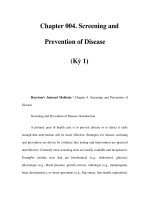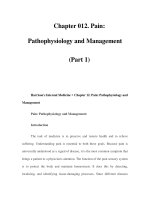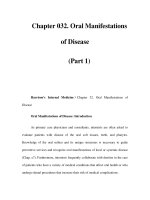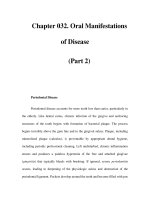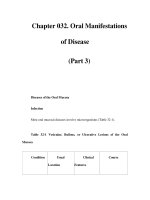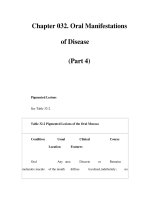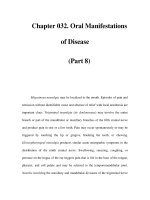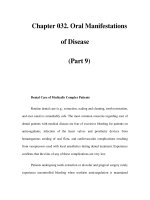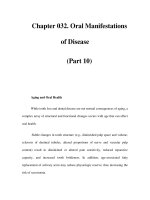Chapter 123. Clostridium difficile–Associated Disease, Including Pseudomembranous Colitis (Part 1) pptx
Bạn đang xem bản rút gọn của tài liệu. Xem và tải ngay bản đầy đủ của tài liệu tại đây (81.99 KB, 4 trang )
Chapter 123. Clostridium difficile–Associated Disease,
Including Pseudomembranous Colitis
(Part 1)
Harrison's Internal Medicine > Chapter 123. Clostridium difficile–
Associated Disease, Including Pseudomembranous Colitis
Etiology and Epidemiology
C. difficile is an obligately anaerobic, gram-positive, spore-forming bacillus
whose spores are found widely in nature, particularly in the environment of
hospitals and chronic-care facilities. CDAD occurs most frequently in hospitals
and nursing homes where the level of antimicrobial use is high and the
environment is contaminated by C. difficile spores.
Clindamycin, ampicillin, and cephalosporins were the first antibiotics
associated with CDAD. The second- and third-generation cephalosporins,
particularly cefotaxime, ceftriaxone, cefuroxime, and ceftazidime, are agents
frequently responsible for this condition, and the fluoroquinolones (ciprofloxacin,
levofloxacin, gatifloxacin, and moxifloxacin) are the most recent drug class to be
implicated in hospital outbreaks. Penicillin/β-lactamase-inhibitor combinations
such as ticarcillin/clavulanate and piperacillin/tazobactam pose significantly less
risk. However, all antibiotics, including vancomycin and metronidazole (the
agents most commonly used to treat CDAD), have been found to carry a risk of
subsequent CDAD. Rare cases are reported in patients without prior antibiotic
exposure.
C. difficile is acquired exogenously, most frequently in the hospital, and is
carried in the stool of symptomatic and asymptomatic patients. The rate of fecal
colonization is often ≥20% among adult patients hospitalized for >1 week; in
contrast, the rate is 1–3% among community residents. The risk of C. difficile
acquisition increases in proportion to length of hospital stay. Asymptomatic fecal
carriage of C. difficile in healthy neonates is very common, with rates often
exceeding 50% during the first 6 months of life, but associated disease in this
population is rare. Spores of C. difficile are found on environmental surfaces
(where the organism can persist for months) and on the hands of hospital
personnel who fail to practice good hand hygiene. Hospital epidemics of CDAD
have been attributed to a single C. difficile strain and to multiple strains present
simultaneously. Other identified risk factors for CDAD include older age, greater
severity of underlying illness, gastrointestinal surgery, use of electronic rectal
thermometers, enteral tube feeding, and antacid treatment. Use of proton pump
inhibitors may be a risk factor.
Pathology and Pathogenesis
Spores of toxigenic C. difficile are ingested, survive gastric acidity,
germinate in the small bowel, and colonize the lower intestinal tract, where they
elaborate two large toxins: toxin A, an enterotoxin, and toxin B, a cytotoxin. These
toxins initiate processes resulting in the disruption of epithelial-cell barrier
function, diarrhea, and pseudomembrane formation. Toxin A is a potent neutrophil
chemoattractant, and both toxins glucosylate the GTP-binding proteins of the Rho
subfamily that regulate the actin cell cytoskeleton. Disruption of the cytoskeleton
results in loss of cell shape, adherence, and tight junctions, with consequent fluid
leakage. A third toxin, binary toxin CDT, was previously found in only ~6% of
strains but is present in all isolates of the newly recognized epidemic strain (see
"Global Considerations," below); this toxin is related to C. perfringens iota toxin.
Its role in the pathogenesis of CDAD has not yet been defined.
The pseudomembranes of PMC are confined to the colonic mucosa and
initially appear as 1- to 2-mm whitish-yellow plaques. The intervening mucosa
appears unremarkable, but, as the disease progresses, the pseudomembranes
coalesce to form larger plaques and become confluent over the entire colon wall
(Fig. 123-1). The whole colon is usually involved, but 10% of patients have rectal
sparing. Viewed microscopically, the pseudomembranes have a mucosal
attachment point and contain necrotic leukocytes, fibrin, mucus, and cellular
debris. The epithelium is eroded and necrotic in focal areas, with neutrophil
infiltration of the mucosa.
Figure 123-1
Autopsy specimen showing confluent pseudomembranes
covering the
cecum of a patient with pseudomembranous colitis. Note
the sparing of the
terminal ileum (arrow).
